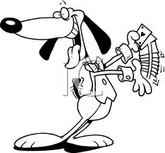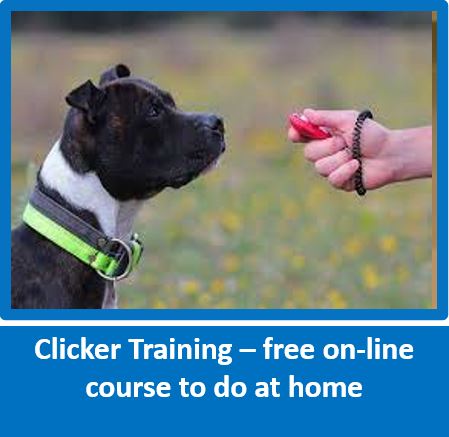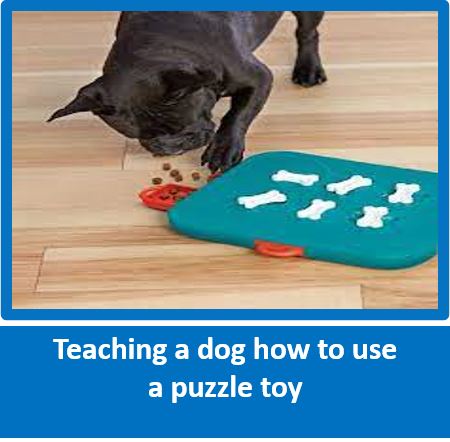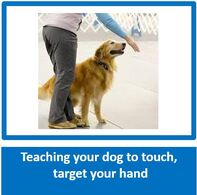
Interacting with your dog by way of using food puzzles and teaching tricks is a wonderful way to build the bond, supply entertainment, and most importantly, supply much needed mental stimulation. Making use of a clicker for teaching tricks makes the process easier, plus the clicker can be used for both obedience and behaviour modification, and so simply to use. The Rosewood clicker has 3 options for sounds, making it perfect for any dog that is a bit nervous of loud noises. www.mcmac.co.za
TEACHING YOUR DOG TO DO TRICKS
Guest Contributor - Louise Thompson
Accredited Animal Behaviour Consultant (ABC of SA ©®™)
.

- It can be great fun for family and friends to see your dog performing tricks. It is also another way to give your dog some added mental stimulation, getting your “best friend’s” old “grey matter” to work a bit more!
a marker that tells the dog, "You’re right – I am pleased with you!" I have proved that it makes no difference if the “marker” is a word, a noise, a clicker or some other sound. In all cases, the same basic principles of positive reinforcement apply. However, the clicker certainly makes it easier and the human reaction time seems to be better when using the clicker.
A conditioned reinforcer word:
To teach a conditioned reinforcer word you must first choose a marker word (Choose a word that you are not likely to use in everyday conversation like "yay" or "YESS or Yippee!"),
To make a conditioned reinforcer sound: You can use a clicker, A tongue cluck. A lid from a Snapple bottle works, A ballpoint pen clicking on and off. Remember it must always be the same, sound the same and immediately be followed by a reward – EVERY TIME!
To teach the dog that the marker means reward,
(A reward = a food treat is coming), sit in a quiet place with a handful of dog treats. Make the sound and then pop a treat/feed immediately.
Repeat about 10 times. Then ask the dog for a behaviour that the dog knows really well and can already perform reliably, such as “Sit”.
Give him the command, "Sit," and then mark the behaviour with your special sound and immediately pop him a treat/feed. To be effective, you must feed every time you use the marker.
It is important to be patient when teaching your dog any new behaviour’s. If your dog appears to be a bit slow, or isn't doing what you want it to do, give the dog time to learn. If you become frustrated, stop training before you loose your cool and do any damage, and start again later or the next day. Make you are training make sessions fun -- for both you and your dog.
Most dogs can learn most of the tricks described here. A few dogs will be able to learn all of the tricks. The easiest tricks to teach are those that take advantage of the natural behaviour of the dog.
For example.
- Dogs that like to bark can learn to "speak" easily.
- Dogs that naturally extend their paws and use their feet
- Some dogs have good balance and can "sit up” which is an almost instinctive behaviour (depending on shape and size)
- Others lack this balance and can never do this trick successfully, no matter how hard they try. Usually this is due to the individual animal’s conformation or the way its body is put together.
If the dog does not catch on at first, do not give up; keep trying. If your dog cannot do something even though it tries really hard to please you, rather quit or give up before the dog become frustrated and you loose your temper and spoil what was already learnt. It would be a good idea at this time to quickly move on to another exercise or trick or onto something else that the dog is good at.
Shake hands.
With your dog in the “Sit” position, reach down and take hold of its right paw with your right hand and gently lift his paw slightly.
Tell your dog "Shake!" as you do it. Lift his paw until it is level of the dog's chest and then shake it gently just as though you were shaking a humans hand in greeting. Immediately mark the behaviour, reinforce and pop his treat with lots of praise. Repeat at least six times a day for a few days, then just try reaching out for the paw, but do not take it.
If the dog lifts its paw, take it and shake it gently, marking, reinforcing and then praising. Keep up the praise. You can encourage this behaviour by holding a treat tightly cupped in your hand. Some dogs will paw at your hand.
Mark the behaviour and reward. Alternatively, put a piece of tape on the bottom of your dog's foot…. the dog will probably lift a paw to get rid of the tape. Mark the behaviour as dog lifts a paw followed by immediate praise/reward.
Wave.
This is a variation of "shake hands." Wave at the dog; be sure to use a signal that is unlike any that you use
in obedience training or any other activity or command. At the same time, tell the dog, "wave." You can encourage this behaviour by gently touching the dog's paw with your right hand as you wave with your left and say, "wave."
Roll over.
Make learning this trick a game. Get down on the floor with your dog and wait until it is lying on its side. Put one hand in the middle of its back, your other hand under its chest and shoulders. Tell your dog "Roll over!" and turn it gently over as you do so. When it is over, mark the behaviour, followed by immediate praise/reward. Do this three or four times a day. Once the dog gets the idea, cut down on your assistance until the dog is doing it on its own. Keep up the praise.
An alternative method is to lure the dog over by using food held just about an inch from its nose. Once the dog is over, mark the behaviour, followed by praise and the food reward.
Roll over and Play “Dead”
Teach the “roll over” as per the previous section.
Once the dog is able to perform it on command, then simply add the word “bang” with an accompanying hand signal,
preferably your hand and finger pointed at him in the shape of a gun.
It does take a bit of time to get the dog to associate the pointed gun-finger (which is in fact a hand signal) with the verbal command “bang” but after a few repetitions per day most dogs “get it” quite quickly.
The next step is to start rewarding the dog for speed. The quicker he drops and rolls over the better treat he gets and the verbal praise is more exuberant.
Gradually start making your voice more exciting and a little bit sharper. Make sure that you pop the treat as soon as he is in position. After some time you will find that the command “bang” accompanied by the gun hand / pointed finger is all that is needed.
The next step is to get him to “wait” in the “dead” position for a second or two. Initially you can hold him in the position for a second or two with the food treat, whilst repeating the word “wait”. Pop the treat in his mouth with the words (to reinforce the position) “good wait”. Gradually over a period of time, make him wait longer and longer – up to about 10/20 seconds for effect! Some dogs do this so well it has been used in the movies and it becomes quite a clever party trick.
Sit up & Beg.
Sitting up is an entirely unnatural position for a dog, so it will have to be helped at first (a few dogs can never physically perform this trick – think of the dog’s conformation).
To start, sit it in a corner, facing out. Tell your dog "Sit up!" and lift it gently with your hand on dog's chest until dog is in an erect sitting position. Keep it there a few moments, and then put one finger under dog's chin to help your dog keep its balance. Repeat the command, hold the dog there for a few seconds, and then let it down. Mark the behaviour, praise and pop the treat. Repeat this six times a day until the dog will stay without your help once you have got him up. Then keep working on this trick until the dog goes up by himself.
Caution:
Do not hold the dog in a sit-up position too long – especially in the beginning. It can hurt or damage the dogs back before the muscles get a chance to become accustomed to this exercise. If this happened, the dog will become discouraged (as he would be physically uncomfortable) and will not want to do this trick.
Important
Do not perform this trick with puppies.
Dogs need to be mature and their orthopaedics fully formed before they are physically stable enough especially with large breeds. Performing this exercise, prior the bones being fully formed may result in permanent damage! Other breeds that SHOULD NOT be taught this exercise are Dachshunds, Basset Hounds and any other long bodied shaped dogs. Due to the abnormal length of their bodies, it can cause spinal injury and even permanent damage. It could also exasperate any genetic back/spine problem often seen in some of these breeds.
Catch.
The best time to practice this trick is just before mealtime when the dog is hungry. Stand close in front of your dog and toss it small bits of food, saying, "Catch" as you throw them. What the dog catches it will eat. If the dog does not catch it, be quick and remove the bits of food so the dog is not rewarded for missing the “catch”. Most dogs “catch on” (excuse the pun) really quickly and will get the idea that the more treats he catches, the more treats they gets to eat.
Especially in the early stages of learning, try to make it as easy as possible for the dog to catch the food you throw. You can increase the distance and/or make it more difficult later. Rather try to ensure that the dog does not fail in the beginning. Popcorn, without salt or butter, is good for teaching this.
Say Your Prayers.
Select a chair in the house for your dog to use. Make sure that the chair is heavy enough so it will not slide when the dog leans his weight against it. The chair should also be just high enough for your dog to rest its forepaws on comfortably.
Take your dog to the chair and sit the dog in front of the chair. Give the command, "Say your prayers." As you do this, simultaneously lift its front feet and place them on the edge of the chair and gently lower the dog’s chin, until the chin is resting on his paws. Soothe your dog with kind words as you do this whilst you gently hold the dog in the position a few moments and then release with much praise. As with all other tricks it is simply, a matter of repetition until the dog gets the idea and performs the trick on its own.
One difficulty with this trick is the placement of the head. Holding the head in a certain position is something quite foreign to dogs and it may take many repetitions before the dog understands this particular part. Keep at it with patience and praise until your dog catches on. Obedience training in the "stay" is helpful here. Don’t forget to mark the behaviour, praise and pop a treat.
Bring the newspaper.
Here tricks come into the area of usefulness because it can be quite handy to have your dog bring the evening newspaper, your shoes, or whatever you happen to want but are too lazy or tired to get up and get yourself.
Once your dog has learned the basics of getting and bringing to you any one thing, it can be taught to identify a number of items by name and thus be taught to bring each and any of these items to you on command.
First, the dog must learn the simple retrieve.
Without the necessity of going into the regular full obedience retrieve, you can get the idea across to your dog by simply playing ball. Throw a ball and let your dog bring it back to you in play. Go on from this to throwing a stick, a rolled-up newspaper, a glove, or any item small enough for your dog to carry but large enough so that he wont be able to swallow the item. When the dog is carrying things happily for you, give your dog a newspaper to carry. Give him the command, "Bring the paper" or "Fetch the paper" and encourage your dog to bring it to you.
At first, you will need to go outside with the dog to encourage it to pick up the paper and bring it in. Take the paper from the dog when it gets inside. Then give the dog lots of praise and a treat.
After about 10 days or so, the dog will be getting the idea and you can stand at the door and tell it to get the paper. Whenever the dog does go out and brings back the paper, be sure to praise a lot. Note: if your dog is likely to run away when off lead, do not try this trick.
When you want your dog to bring anything other than the paper, you will have to work with the dog on each item providing each item with a name, which should always said in the same voice, with the same accompanying body language and reward. Remember to always be consistent! It will not take as long to teach, but you must be patient. I once had a student who owned a Bullterrier puppy who at the age of five months could differentiate over 20 different names of object/toys on command! So it can be done! At first, the dog will be confused so be sure to praise. If you tell the dog "no" and act angry, it will think you are upset because it brought you something. The dog will not understand that it brought the wrong thing.
Crawl.
To teach your dog to crawl, you need a chunk of its favourite food. Tell the dog to lie down. Place your left hand over but not touching his back. Hold the food in your right hand, out a foot or two in front of its face.
Tell your dog "Crawl" and start slowly moving the food away. If the dog starts to stand up, gently help it back down with your left hand and command "Crawl" again. Repeat several times a day. When the dog actually crawls, even two or three steps, mark the behaviour, praise simultaneously whilst giving him the treat. Eventually he will get the idea that it must crawl a little way before it gets a treat.
“High Five”
This trick can be taught with or without a marker, either using the basic principles outlined in the rest of this booklet or by following an alternative method set out below.
First, start out with your dog in the SIT position facing you. Now, with your dog sitting in front of you, gently tickle the hairs on one of the dog's front paws.
THIS PART IS CRUCIAL: As soon as your dog's paw moves, praise your dog and give a treat. It's important to praise and reward your dog immediately ....even if the paw just barely moves. Now repeat this process quickly until your dog starts to pick up the same foot ... without you tickling the hairs. (It might take a few repetitions, but your dog will get the hang of it.)
Next, you want to keep praising and rewarding, him every time the paw comes up ...but gradually withhold your praise until his paw comes up a little higher each time. Your goal is to have your dog's paw come up about chest high. (..Your dog's chest, that is :-) Once he raises the paw to chest height CONSISTENTLY, add the command "high five" just before rewarding and praising ...while the paw is in the air.
So if you were to map this out in your dog's mind, the "timeline" for this trick would look like this:
COMMAND ---> DESIRED BEHAVIOUR ---> REWARD
It's pretty simple, really.
I MUST ADD THAT ALL OF THE ABOVE ARE EASIER IF THE DOG IS ALREADY AT LEAST PARTIALLY EXPOSED TO SOME BASIC DOG SCHOOL OBEDIENCE




